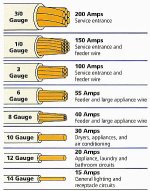NH Mike
Bronze Member
- Joined
- Nov 19, 2009
- Messages
- 83
- Location
- Atkinson, NH
- Tractor
- ASV PT-60, Case 310B, Deere B, Ford 8N, Hustler Raptor SD.
Take a look at the plate on your winch. It should list the maximum amperage the winch will draw, let's say 150 amps. Decide where you are going to locate the unit and measure the round trip length ( if it's 5' from the battery then you will have a 10' circuit, power out and back. Take those numbers and plug them into this chart,
(http://www.crcorp.com/DCT_HardwareEssentials/E/pdf/E11.pdf)
This will give you the proper wire size for your application. Then you match the connectors to the wire size.
Hope this helps
Mike.
I'm a certified marine electronics tech.
(http://www.crcorp.com/DCT_HardwareEssentials/E/pdf/E11.pdf)
This will give you the proper wire size for your application. Then you match the connectors to the wire size.
Hope this helps
Mike.
I'm a certified marine electronics tech.
